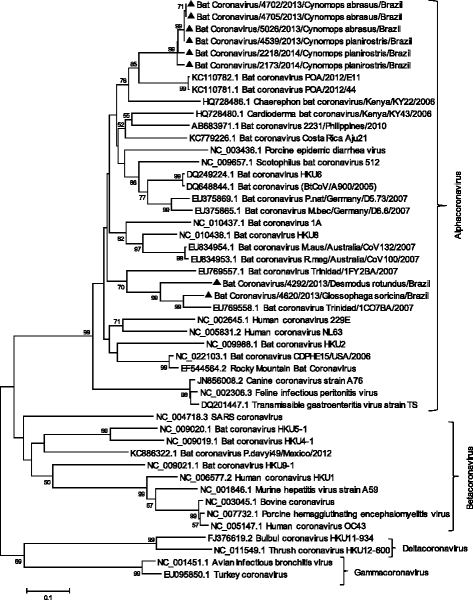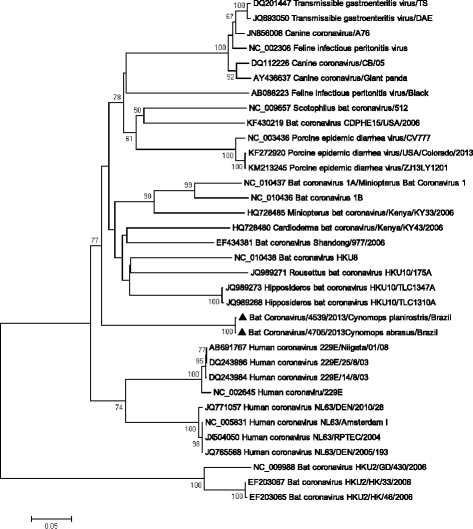Alphacoronavirus in urban Molossidae and Phyllostomidae bats, Brazil
- PMID: 27342195
- PMCID: PMC4920988
- DOI: 10.1186/s12985-016-0569-4
Alphacoronavirus in urban Molossidae and Phyllostomidae bats, Brazil
Erratum in
-
Erratum to: Alphacoronavirus in urban Molossidae and Phyllostomidae bats, Brazil.Virol J. 2016 Jul 7;13(1):124. doi: 10.1186/s12985-016-0581-8. Virol J. 2016. PMID: 27388456 Free PMC article. No abstract available.
Abstract
Background: Bats have been implicated as the main reservoir of coronavirus (CoV). Thus the role of these hosts on the evolution and spread of CoVs currently deserve the attention of emerging diseases surveillance programs. On the view of the interest on and importance of CoVs in bats the occurrence and molecular characterization of CoV were conducted in bats from Brazil.
Findings: Three hundred five enteric contents of 29 bat species were tested using a panCoV nested RT-PCR. Nine specimens were positive and eight was suitable for RdRp gene sequencing. RdRp gene phylogeny showed that all CoVs strains from this study cluster in Alphacoronavirus genus, with one Molossidae and one Phlyllostomidae-CoV specific groups. Phylogenetic analyses of two S gene sequences showed a large diversity within the Alphacoronavirus genus.
Conclusions: This study indicated a CoV-to-host specificity and draws attention for CoV detection in Cynomops sp, a potential new reservoir. The phylogenetic analyses indicate that diversity of CoV in bats is higher than previously known.
Keywords: Bat; Coronavirus; Molossidae; Phyllostomidae.
Figures


Similar articles
-
Detection and characterization of diverse alpha- and betacoronaviruses from bats in China.Virol Sin. 2016 Feb;31(1):69-77. doi: 10.1007/s12250-016-3727-3. Epub 2016 Feb 2. Virol Sin. 2016. PMID: 26847648 Free PMC article.
-
Diversity of coronavirus in bats from Eastern Thailand.Virol J. 2015 Apr 11;12:57. doi: 10.1186/s12985-015-0289-1. Virol J. 2015. PMID: 25884446 Free PMC article.
-
Longitudinal study of age-specific pattern of coronavirus infection in Lyle's flying fox (Pteropus lylei) in Thailand.Virol J. 2018 Feb 20;15(1):38. doi: 10.1186/s12985-018-0950-6. Virol J. 2018. PMID: 29463282 Free PMC article.
-
Global Epidemiology of Bat Coronaviruses.Viruses. 2019 Feb 20;11(2):174. doi: 10.3390/v11020174. Viruses. 2019. PMID: 30791586 Free PMC article. Review.
-
Coronaviruses in Bats: A Review for the Americas.Viruses. 2021 Jun 25;13(7):1226. doi: 10.3390/v13071226. Viruses. 2021. PMID: 34201926 Free PMC article. Review.
Cited by
-
Metagenomic of Liver Tissue Identified at Least Two Genera of Totivirus-like Viruses in Molossus molossus Bats.Microorganisms. 2024 Jan 19;12(1):206. doi: 10.3390/microorganisms12010206. Microorganisms. 2024. PMID: 38276191 Free PMC article.
-
Corona- and Paramyxoviruses in Bats from Brazil: A Matter of Concern?Animals (Basel). 2023 Dec 26;14(1):88. doi: 10.3390/ani14010088. Animals (Basel). 2023. PMID: 38200819 Free PMC article. Review.
-
Virome analysis of Desmodus rotundus tissue samples from the Amazon region.BMC Genomics. 2024 Jan 4;25(1):34. doi: 10.1186/s12864-023-09950-w. BMC Genomics. 2024. PMID: 38177994 Free PMC article.
-
Coronavirus sampling and surveillance in bats from 1996-2019: a systematic review and meta-analysis.Nat Microbiol. 2023 Jun;8(6):1176-1186. doi: 10.1038/s41564-023-01375-1. Epub 2023 May 25. Nat Microbiol. 2023. PMID: 37231088 Free PMC article.
-
Bats (Mammalia: Chiroptera) in urban-rural interfaces: community structure associated with pathogen screening in São Paulo-the largest metropolitan region in Brazil.Vet Res Commun. 2023 Sep;47(3):1575-1600. doi: 10.1007/s11259-023-10112-2. Epub 2023 May 8. Vet Res Commun. 2023. PMID: 37154860 Free PMC article.
References
-
- De Groot RJ, Baker SC, Baric R, Enjuanes L, Gorbalenya AE, Holmes KV, et al. Family coronaviridae. In: King A, Adams M, Cartens E, Lefkowitz E, et al., editors. Virus taxonomy: classification and nomenclature of viruses: ninth report of the International committee on taxonomy of viruses. San Diego, CA: Elsevier Academic Press; 2012. pp. 806–20.
-
- Woo PCY, Lau SK, Lam CS, Lau CC, Tsang AK, Lau JH, et al. Discovery of seven novel Mammalian and avian coronaviruses in the genus deltacoronavirus supports bat coronaviruses as the gene source of alphacoronavirus and betacoronavirus and avian coronaviruses as the gene source of gammacoronavirus and deltacoronavirus. J Virol. 2012;86:3995–4008. doi: 10.1128/JVI.06540-11. - DOI - PMC - PubMed
Publication types
MeSH terms
LinkOut - more resources
Full Text Sources
Other Literature Sources
Research Materials

